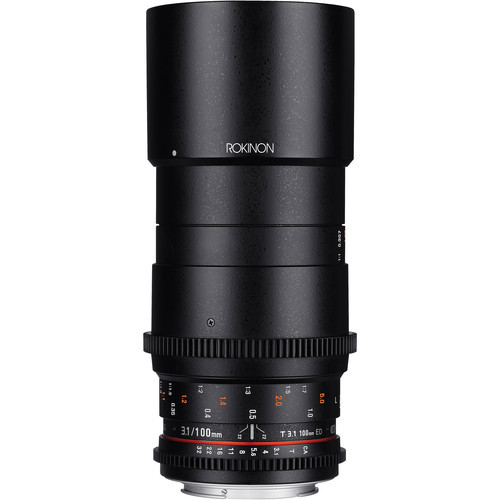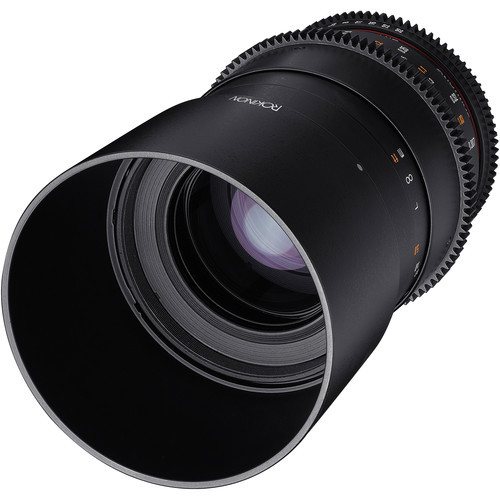Rokinon 100mm T3.1 Macro Cine DS Lens for Micro Four Thirds
Versatile Telephoto Macro for Cinematic Close-Ups
The Rokinon 100mm T3.1 Macro Cine DS Lens for Micro Four Thirds is a precision-engineered cinema lens designed for filmmakers demanding creative flexibility, life-size 1:1 macro capabilities, and sharp, detailed close-up shots. It’s part of the acclaimed Cine DS lineup, giving users standardized gear positioning, reliable manual control, and color-matched optics across a set—vital for seamless switching between prime lenses during a production.
Macro Mastery: 1:1 Magnification
At its core, this lens is a true macro, offering up to 1:1 reproduction of subjects on the sensor. The optical formula includes 15 elements in 12 groups, engineered to deliver edge-to-edge sharpness, minimal chromatic aberrations, and very low distortion—even at close focus. Seen through a Micro Four Thirds sensor, the 100mm focal length gives a highly telephoto perspective, making it an excellent choice for extreme close-ups, product cinematography, nature shorts, tabletop sequences, and science/educational content.
A minimum focusing distance of just 0.307m (about 1 foot) lets filmmakers fill the frame with small subjects while still enjoying a razor-thin depth of field, resulting in isolated, dramatic visuals. This enables unique cinematic shots—showcasing textures, insects, food, or fine mechanical elements with hyper-real detail and bokeh-laden backgrounds.
T3.1 Aperture and 9-Blade Iris for Creative Control
The T3.1 maximum aperture translates to strong low-light performance and the ability to blur backgrounds aggressively for a cinematic 'pop.' The 9-blade circular aperture ensures pleasing, rounded out-of-focus highlights, elevating the aesthetic of macro, portrait, or telephoto video work.
Even though T3.1 is not as wide as some portrait primes, the effect at macro ranges is dramatic: a tiny movement shifts the focal plane perceptibly, giving directors and DPs the ability to steer audience focus with precision. This extremely shallow focus—paired with 1:1 magnification—makes the lens ideal for product shots, food cinematography, and stylized creative sequences.
Cine DS: Matched Gear and Fluency in Production
A Cine DS hallmark, all physical controls sit in the same place across the range. This uniformity allows focus pullers and camera assistants to swap between lenses without repositioning follow focus units or iris gears. Focus and T-stop scales are printed on both sides of the barrel, coated in glow-in-the-dark paint for rapid reference in low light or blacked-out studio environments—ideal for fast-paced or multi-cam shoots.
The de-clicked aperture ring offers silent, smooth iris pulls while filming, critical for exposure adjustments in a live take. The focus ring, with around 180 degrees of throw, is finely damped for exacting focus pulls—a feature pro cinematographers demand for macro and portraiture sequences.
Build Quality and Practical On-Set Features
The lens balances robust metal construction with portability (81.6mm diameter, 149mm length, and a practical 67mm filter thread). The removable lens hood guards against flare—even without a matte box—and the sturdy front thread allows polarization, ND, or diffusion filters to be fitted for exposure or creative effects.
Though the Cine DS version is manual focus only—there’s no image stabilization or electronics—this is an advantage for seasoned video shooters prioritizing repeatability and tactile feedback over automation.
Image Quality in the Real World
Independent testers and filmmakers note exceptional center sharpness—even wide open—with edges becoming crisp by T8 or below. The lens is prized for its ability to maintain color consistency with other Rokinon DS primes, permitting seamless footage intercuts. Bokeh is rich, highlights are rounded, and flare is well-controlled thanks to anti-reflective UMC coatings.
Its only notable drawbacks are the lack of IS (requiring a tripod for macro work) and relative size on smaller MFT bodies compared to native glass. However, in a cinema or studio rig, these factors are often irrelevant.
Who Should Use This Lens?
-
Product shooters
-
Food and detail-oriented filmmakers
-
Science, tabletop, and documentary teams
-
Directors aiming for intimate, stylized close-ups
-
Anyone who needs smooth manual control for macro or telephoto work on a Micro Four Thirds camera
Summary & Conclusion
The Rokinon 100mm T3.1 Macro Cine DS Lens for Micro Four Thirds delivers outstanding macro and telephoto results in a cinema-optimized package. Its 1:1 magnification, color-matched optics, smooth and silent controls, and rugged build make it a go-to for close-up filmmaking. Despite lacking autofocus or stabilization, its image quality and handling punch far above its price point, adding creative power to any MFT-based cine rig.











